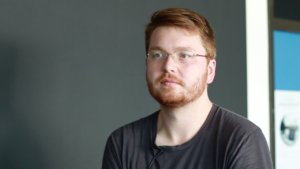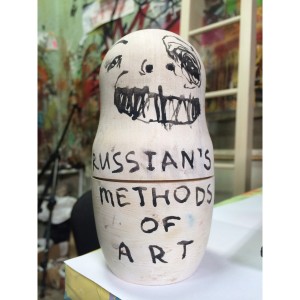Each project, this is my work supposition, depends on the material. There is an idea and there is a bond of material or a decision of material and they apply to this project until something else applies. So, for example, with the 72 families, there was indeed only the structure. I will exchange something in São Paulo, but I do not know what I will actually get in the end. Of course, in the slums I might rather get bulbs or maybe a lamp with a fan, because the air conditions are so incredibly bad that you also want to have a fan in there. I did not know what I would get, but I knew that if I received something, it would have an authenticity in this project and it would be linked to the families and their privacy. And this is the category. This is the material. Not the lamp itself, but the idea that is reflected with this lamp in this diversification of 72 families or mirrored in these 100 stories. And this is the material and this is perhaps the difference. It’s not what you can see, what you get, but rather what is behind it. This is actually the work, the idea and the project. The material is the metaphysical space where the ideas can develop. That is how I understand teaching and how I also understand artistic practice. I do not have a high affinity for material. I may think for example the projector 2050 from Kodak in the 50s is a particularly successful, even a design object and I find certain video projectors particularly appealing in a way, or certain cameras, but it is not the material fetishism that provokes me. It is not something in bronze, something that is brought on a formula of eternity, but it is rather: What material does it need to make a registration on this site for a certain period of time? And this is what the material is measured with.
Jedes Projekt bedingt das Material. Das wäre jetzt meine Arbeitshypothese. Es gibt eine Idee und da gibt es die Materialbindung oder eine Materialentscheidung und die gilt erst mal für dieses Projekt, solange bis was Anderes gilt. Also zum Beispiel bei den 72 Familien stand ja nur die Struktur. Ich tausche in Sao Paulo. Ich wusste aber nicht was ich am Ende bekomme. Natürlich bekomme ich in den Slums eher Glühbirnen oder vielleicht mal eine Lampe mit einem Ventilator, weil die Luftbedingungen dort so wahnsinnig schlecht sind, dass man auch gleich einen Ventilator da dran haben möchte. Ich wusste nicht was ich bekomme aber ich wusste, dass wenn ich was bekomme, dass es sozusagen eine Authentizität hat im Projekt selber mit den Familien rückgekoppelt und deren Privatraum. Und das ist die Kategorie. Das ist das Material. Nicht die Lampe selbst, sondern die Idee, die sich mit dieser Lampe in dieser Diversifikation von 72 Familien oder in den 100 Geschichten widerspiegelt. Und das ist dann sozusagen das Material und das ist dann vielleicht auch ein bisschen so der Unterschied. Das was man bekommt, ist eben nicht was man sieht. Sondern was hinter dem steckt, was man zu sehen bekommt, ist eigentlich die Arbeit, die Idee und damit eben auch das Projekt. Das Material ist der metaphysische Raum, in dem sich die Idee entwickeln kann. So begreife ich Lehre und so begreife ich auch künstlerische Praxis. Ich habe keine hohe Materialaffinität. Ich finde zwar jetzt vielleicht den Projektor 2050 von Kodak aus den 50er Jahren ein besonders gelungenes, auch Design- , Objekt und finde auch bestimmte Videoprojektoren besonders ansprechend in einer Form oder bestimmte Kameras, aber es ist nicht der Materialfetischismus, der mich treibt. Es ist nicht das in Bronze, auf eine Ewigkeitsformel bringende, sondern es ist eher: was braucht es an Material, um an dieser Stelle für eine bestimmte Zeit eine Einschreibung vorzunehmen? Und daran wird das Material gemessen.

















